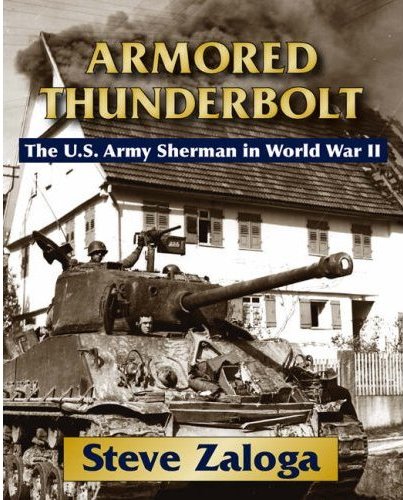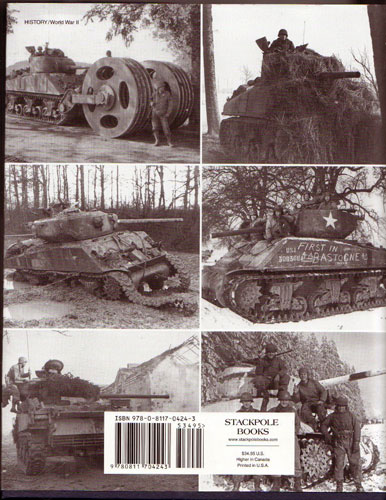|
|
|
|
| Home > Reviews > USA > Armored Thunderbolt The U.S. Army Sherman in World War II by Steven J. Zaloga |
Armored Thunderbolt
The U.S. Army Sherman in World War II
by Steve Zaloga

Reviewed by Al Bowie
Summary
Title: |
ARMORED THUNDERBOLT – The U.S. Army Sherman in World War II |
ISBN: |
978-0-8117-0424-3 |
Media and Contents: |
Hardback; 360 pages with B&W photos and diagrams |
Price: |
Marked at $34 US but available cheaper |
Review Type: |
First Read |
Advantages: |
An analysis of the Sherman as a weapon system from a strategic and doctrinal level supported by excellent research and a huge collection of photos. |
Disadvantages: |
None identified |
Recommendation: |
Highly recommended to Armour and historical enthusiasts as well as armchair generals. |
Publisher |
Stackpole Books |
FirstRead
Steve Zaloga is known to many modellers and history buffs as a prolific writer of serious studies of Armoured warfare, US and Russian Armour, as well as superb modelling books on mainly WW2 US Armour. He has written many Osprey titles on the same subjects and is a regular contributor to Military Modelling of superb modelling articles packed with useful historical background. Following on from his latest osprey title in the Duel Series: Panther vs Sherman, this is a title and a subject Steve is eminently qualified to write upon.
This book is not a typical book on an armoured vehicle and whilst it discusses technical points it is focussed on the Sherman Tank as a weapons System and how it fitted into the Allied Military machine. It is thoroughly researched and examines how the Sherman came about, how it fitted into the US Army doctrine and how it was employed.
 It is not a book for the modeller to find out the differences between Sherman variants but more for the Historian who wants to understand how the Sherman evolved, why it evolved and what impact it had on the face of Armoured warfare in WW2 and beyond. It examines the strengths and weaknesses and how these were overcome throughout the Sherman’s long career. The politics, personalities and doctrine that shape US armoured forces in WW2 and beyond are examined in detail.
It is not a book for the modeller to find out the differences between Sherman variants but more for the Historian who wants to understand how the Sherman evolved, why it evolved and what impact it had on the face of Armoured warfare in WW2 and beyond. It examines the strengths and weaknesses and how these were overcome throughout the Sherman’s long career. The politics, personalities and doctrine that shape US armoured forces in WW2 and beyond are examined in detail.
The book is 360 pages well supported with high quality black and white images not just of Shermans but associated US vehicles and the predecessors of the Sherman. The book covers a lot and is written in an easy to follow narrative presented in Steve’s usual logical sequence all well supported by an excellent bibliography and clear photos.
The book is broken up into logical chapters and covers the following areas:
Introduction
-
War of the Machines – This has sub chapters covering early US tanks , the Military Situation regarding Armour pre and early war, the allies experience of Blitzkreig, the shaping of US doctrine etc
-
Birth of the Sherman – Concentrates on early development, the layout and components of the Sherman, Dynamics of US tank Development, Personalities, baptism of Fire and the British Sherman
-
Panzer Nemesis – The Tank Destroyer concept 7 Doctrine, Infantry support, The Italian campaign lessons; the threat of AT Rockets and Enemy armour threat including specific comparison with the Panther
-
The Future Sherman: Improve or Replace? – Sherman Generations , the 76 mm gun controversy, the Sherman Replacement and its debate, Innovations and family members such as the SPG’s, Jumbos and TD’s and the British Approach
-
Bocage Buster – Omaha, Hedgerow fighting, overcoming the hedgerows, Operation Cobra and vulnerabilities
-
To Paris and beyond! – the breakout, taming the Panther, US firefly deference, Arracourt, better ammunition and US Blitzkrieg
-
Through the Mud & the Blood – Siegfried battles, Sherman Funnies, Bunker busting, Better TDs, HVSS & Mobility, T26, Dynamics of Tanks vs Tank and the Statistics of tank fighting
-
Armoured Superiority in the Ardennes – Defence, Counterattack, offensive and recriminations (Public & Political perception of US Armour vs German) and Ardennes lessons
-
Onto the Rhine – Firepower improvement, more armour and Zebra Mission
-
From Bloody Tarawa to the Sands of Iwo Jima – USMC and Army Sherman operations in the Pacific examined
-
Cold War Sherman – Korea, Arab Israeli conflicts
-
Appendix A – Technical and production Data
-
Sherman technical Data in tables
-
Manufacture and Distribution 42-45
-
Production by Plant
-
Production by type
-
Armour penetration of US guns
-
Appendix B – Sherman Strength and Loss statistics for US forces
-
Appendix C – Allied Data
-
British/Canadian 21st Army Gp Strength NEW
-
British Sherman Designations
-
Lend lease Shipments 42-45
Bibliographic Essay
Index
Conclusion
The great thing about this book does is that it takes oft repeated myths and lays them firmly to rest. In the introduction the author asks the question, was the Sherman a death trap or a war winner. By the end of the book you will have a thorough understanding of how the Sherman came about, the factors that influenced it, its development, use and the way the US and Allies fought their armoured battles. You will also have all the facts to come to your own conclusion however the Author has presented this for you also.
Whether you are a fan or a detractor of the Sherman this is essential reading for the student of armoured warfare and the armchair generals amongst us. I feel this will be one of those essential titles in the library of the aforementioned and is a landmark tome and ranks alongside the now legendary title Hunnicutts Sherman. In fact I feel this is the perfect complement to it and should be compulsory reading for all Shermaholics.
The Sherman has had to wait nearly 60 years but finally someone has put up their hand and gone in to bat for it in a convincing fashion
I cannot recommend this title enough for its insight, breadth of coverage and excellent collection of photos. I could not put the book down once I started reading it. Even at twice its jacket price it is a remarkable bargain.
Book purchased by reviewer
Text and Images by Al Bowie
Page Created 26 October, 2008
Page Last Updated
26 October, 2008

